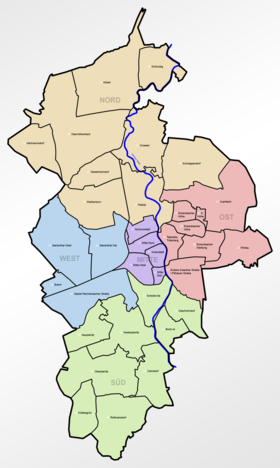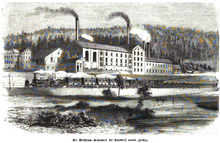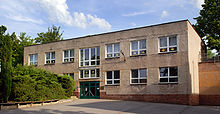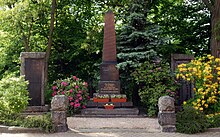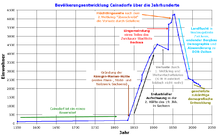Cainsdorf
|
Cainsdorf
City of Zwickau
Coordinates: 50 ° 40 ′ 33 ″ N , 12 ° 29 ′ 26 ″ E
|
||
|---|---|---|
| Height : | 354 (260-391) m | |
| Area : | 3.05 km² | |
| Residents : | 2350 (2007) | |
| Population density : | 770 inhabitants / km² | |
| Incorporation : | January 1, 1999 | |
| Postal code : | 08064 (before incorporation 08122 and 08124) | |
| Area code : | 0375 | |
|
Location of Cainsdorf in Saxony |
||
The formerly independent municipality of Cainsdorf is now a district and a locality of the city of Zwickau , which has been the district town of the Zwickau district in the Free State of Saxony since 2008 . The district of Cainsdorf is located in the district of Zwickau-Süd and has the official number 59.
geography
location
Cainsdorf is located in the outflowing basin of the Vorerzgebirgs depression at the foot of the Erzgebirge on the Silberstrasse in western Saxony. The place is on the west bank of the Zwickauer Mulde .
Neighboring places
| Niederplanitz | Bockwa | |
| Oberplanitz |

|
Niederhasslau |
| Rottmannsdorf | Culitzsch | Wilkau |
history

Foundation and emergence of the place name
The Waldhufendorf Cainsdorf was founded around 1170–1178 by Franconian farmers. It is believed that the village got its name from a settler Caganis or Cagono (the Nordic root word gagn means booty, advantage , ahd.gagan stands for against or exposed , but kaa also stands for hut, shed ). Cainsdorf is first mentioned in writing in 1382 in a deed of gift from Meinhard, Burgrave of Meißen and Count of Hartenstein . By shortening the name, Kanersdorff or Kannersdorff was created around 1460 . Further traditional spellings of the village are z. B. Kanßdorff 1551, Kohnßdorff 1555 and 1618 Canisdorf . In 1696 it was first called Cainsdorff , from 1791 it became Cainsdorf or Kahnsdorf (in the local dialect the name is still pronounced Kahnsdorf today ).
12th to 18th centuries
In 1492, a tailor was the first craftsman to settle in the village. Hard coal has been mined in Cainsdorf since the end of the 15th century . The clustered village , which in 1551 consisted of only 13 landowning families (farmers) and 13 landless people, developed over the centuries into a street village along the cut from Kirchberg to Zwickauer Mulde. Until the 19th century, Cainsdorf belonged to the manor of Planitz Castle . In the 18th century there is evidence of a farm in Cainsdorf . In 1594, the then Planitz manor owner Heinrich von Beust (July 13, 1559 to December 16, 1627), son of the lawyer Joachim von Beust , proposed the coal mountain foundation . From each large load (100 horse-drawn carts) 1 cart and from each small load (100 carts) 2 carts fell to the Planitz church, in which the Cainsdorf residents were also parish. In the 19th century, the new Parish Cainsdorf was largely financed by this.
At the end of the 15th century, the sandstone for the Marienkirche in Zwickau and the Gewandhaus was quarried from the stone quarries at Hammerwald . Coal mining from near-surface hard coal seams dates around the same time , since at Cainsdorf the overlying layers of the Upper Carboniferous come to the surface above the Variscan folds. As a result, Cainsdorf was shaped by coal mining for centuries . The forecast for the shepherd boy Jörg found the late 12th century on Hammerwald between Cainsdorf and Planitz the black pieces, put them to his fire and was more than surprised when they also caught fire. As early as 1479, a hunter's shot is said to have caused the first coal fire . They should burn more or less hard for the next 450 years. The first evidence of hard coal mining exists with a deed of purchase dated June 29, 1493 from the head of the Zwickau Marienkirche on the so-called Kohl (en) berg . But mostly they were coal farmers , i. H. Farmers who used coal mining as a part-time business and operated coal digging .
In 1551, four citizens of Zwickau and Joachim Schnee, a miller from Cainsdorf, founded a coal-mining union . In their petition they refer to the over 100 year old coal mining in the Bockwaer area.
In the Thirty Years' War , in revenge for three slain looters, imperial Croats attacked the inhabitants, killed many of them and set fire to the majority of the farms. Fires started by the warring parties in the coal shafts at that time ignited them again in 1640. They are known as the Planitz earth fires . Famines (including 1772) or epidemics ( plague , last time in 1681), harsh winters or fires, floods, freak weather or wars - the community has experienced all of this over the centuries. At the terrible cholera - epidemic which raged in 1866 in West Saxony, 40 of the 63 patients died in Cainsdorf.
- Geological natural monument - coal outcrop - the soot coal seam
View in the direction of strike to the right bank of the Mulden. The falling towards the center of Zwickau becomes clear .
19th century
The first Saxon census of 1834 recorded only 168 inhabitants. The forced labor did not end until December 31, 1835. With a pension that ran until 1890 to the von Arnims, who had owned the Planitz estate since 1689, the farmers were able to free themselves from forced labor. Between 1837 and 1868, the botanist and chemist Ernst August Geitner ran a garden nursery at Hammerwald, which used the warmth of the burning Planitz coal seam. He directed the warm emissions of the coal fires into greenhouses, in which southern plants such as palm trees , orchids , cocoa , bamboo and bananas thrive. With the extinction of the coal fires, the time of gardening also ended. Beer was not allowed to be brewed in Cainsdorf until 1839 . Like 30 other villages in the area, they were subject to the Zwickau ban miles . However, since around 1695 there was the right of row tavern for the 14 farmers of the old community . These formed the core of the village community. Reihenschank meant that the right to serve beer shifted from farmer to farmer.
In 1845, Cainsdorf was given municipal independence. The farmer Johann Gottlob Haugk was the first elected community leader . Until 1856 Cainsdorf belonged to the Electoral Saxon or Royal Saxon Office of Zwickau . In 1856 the place came to the Zwickau court office and in 1875 to the Zwickau administration .
Since 1849 there has been a school of its own in Cainsdorf, which in 1858 was teaching 877 children in its own small new building ( church school ) and in 1891 in the large new school building. At the turn of the century there were sometimes more than 1,000 students in school. The school was expanded between 1899 and 1903 (another wing, gym). From 1959 the school was converted into a ten-class polytechnic high school. In 1978 the new extension was inaugurated and the school was given the honorary name " Wilhelm Pieck ". With reunification and the introduction of the three-tier school system in the Free State of Saxony , the school was converted into a primary school from the beginning of the school year in September 1992 . Today the after-school care center uses the extension. The city of Zwickau closed the elementary school in 2012 due to the low number of pupils. Since then it has been run by the independent organization “Christians Make Schools” as the Protestant elementary school “Stephan Roth”, which comes from Wilkau-Haßlau. The purchase agreement was signed in February 2012.
Industrialization began in Cainsdorf as early as the first half of the 19th century. The establishment of the Saxon Iron Company (which the Queen Marienhütte had built in 1839 - named after the Saxon Queen Maria , wife of King Friedrich August II. ) And the railway connection on November 1, 1854 (first as a coal or mine connection line Zwickau-Bockwa, later as Obererzgebirgische Bahn to Schwarzenberg ) changed the place fundamentally. The first Saxon ironworks manufactured u. a. the Paradiesbrücke from Zwickau, a steel riveted bridge , the Markersbach Viaduct and the Loschwitz Elbe Bridge (the so-called Blue Wonder ) from Dresden - Loschwitz - Blasewitz . The high number of workers in the plant led to a rapid increase in the population.
On November 1, 1869, the difficult separation from the Parochie Planitz, carried out from 1860 to 1867, ended , and the new Cainsdorf church by the Dresden architect Nordhoff with its 46 m high tower was inaugurated. The organ (Opus II / 20 - 2 manuals and 20 registers) (a slider chest organ ) comes from the organ builder Conrad Geißler (1825–1897) from Eilenburg . The church has a second masterpiece: The crucifixion group by the wood sculptors Georg Gröne (figures) and Oskar Rühm (Christ) in the middle of the Cainsdorf church, completed in 1895, is the only one that has a metalworker (steel caster) on the left and one on the right, besides the crucified Christ Bergmann ( miner ) shows in their work clothes. On the right gallery is Heinrich von Beust, dressed in knight armor, holding a certificate and a model of the church in his hands. The first pastor was Dr. Moritz Schenkel, who was married to Friedrich Nietzsche's aunt , Ida Oehler, and held office in the parish until 1899.
On September 1, 1879, the age of telegraphy began in Cainsdorf ; the office of Cainsdorf was initially also responsible for Planitz (1885 own office in Oberplanitz, 1888 also in Niederplanitz).
20th century to the present
On January 3, 1924, the Zwickau city council rejected Cainsdorf's application to be incorporated into Zwickau. The reasons were mainly financial.
On April 1, 1939, the municipality of Bockwa was dissolved by order of the Reich Governor of Saxony and divided between Zwickau, Planitz , Cainsdorf, Wilkau-Haßlau and Oberhohndorf . Cainsdorf received an area west of the Zwickauer Mulde of almost 40 hectares and 1450 inhabitants, so that the total number of inhabitants was now 5680 people. In return, the area of the Cainsdorf stop on the Schwarzenberg – Zwickau railway line came to the city of Planitz through an area swap.
In the Second World War , 271 men from Cainsdorf lost their lives (around 5% of the local population at the time). After the invasion of American troops in April 1945, the demarcation line on the Zwickauer Mulde was an allied occupying power until July 1945 and the Americans for four months . After that, Cainsdorf belonged to the Soviet zone of occupation (until October 7, 1949 ). The company sports association (BSG) Horch Zwickau, which was founded on March 14, 1949 by three surrounding clubs, also included the Cainsdorfers. This team won the GDR's first football championship title.
Through the second district reform in the GDR , Cainsdorf came to the Zwickau-Land district in the Chemnitz district in 1952 (renamed the Karl-Marx-Stadt district in 1953 ). In 1954 Cainsdorf had the highest population in its history with 6250 inhabitants. On July 10th of the same year, the people of Cainsdorf experienced the catastrophic flooding of the Zwickauer Mulde, which also led to undercutting, dam breaks and major damage in Cainsdorf. When the river bed was cleared, so-called coherent outcrops appeared at low tide, in which limestone , slate , hard coal, along with numerous fossils and melaphyre, come to light. In Central Europe such outcrops from different geological ages ( Silurian , Devonian , Upper Carboniferous ) belong to rare natural features and have been declared here as a geological natural monument - the " coal outcrop (soot coal seam)".
From 1954 to 1990, the former Königin-Marien-Hütte belonged to the Soviet-German Corporation (SDAG) Wismut ( Operation for Mining and Processing Plants Cainsdorf , BAC for short) as Operation 563 . Mining equipment for uranium mining was manufactured or repaired here. The company later traded as Sächsische Anlagen- und Maschinenbau GmbH (SAM) and, after bankruptcy, is now part of Zwickauer Sonderstahlbau GmbH (ZSB) and employs around 60 people. On February 22, 1958, the agricultural production cooperative (LPG) Clara Zetkin was founded in the village, which almost all farmers gradually joined (partly voluntarily, partly under duress). After the fall of the Wall in 1990, the LPG was dissolved again and the farmers or their descendants got their land back.
Since 1990 Cainsdorf has belonged to the Saxon district of Zwickau, which in its layout corresponded to the former district of Zwickau-Land. In addition to the three-part division of the village ( Unterdorf an der Zwickauer Mulde, Mitteldorf and Oberdorf , settlement towards Wilkau Haßlau), a new residential area behind the church will be added from 1994, which is supposed to be a new home near the town center for around 1000 residents. Between 1994 and 1999 Cainsdorf belonged to the district of Zwickauer Land . On January 1, 1999, Cainsdorf was incorporated into Zwickau (this time against the resistance of the residents themselves). In this context, the town changed its zip code from 08122 and 08124 to 08064. Since 2008, Cainsdorf has been part of the Zwickau district as a district of Zwickau.
traffic
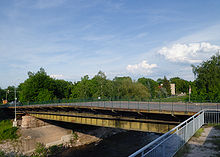
In terms of traffic, Cainsdorf becomes triangular from southwest to east through Autobahn 72 (2 km as the crow flies), from east to north through Bundesstrasse 93 (parallel to the Zwickauer Mulde) and from north to southwest through state road 293 (the Zwickau with the A72 and Lengenfeld connects) framed. Only municipal roads run through Cainsdorf itself.
The bus line 10 of the municipal transport company Zwickau connects the Zwickau city center with Cainsdorf and Wilkau-Haßlau . The line 137 of the regional transport company West Saxony connects the city center of Wilkau-Haßlau with the lower , middle and upper village as well as the settlement in a kind of ring traffic .
Next to the Cainsdorfer Muldenbrücke is the Cainsdorf stop on the Schwarzenberg – Zwickau railway line .
Public institutions, associations and industry
Cainsdorf has a kindergarten and a primary school that is supported by a development association. A large number of other associations, including the volunteer fire brigade and a nationally known wood carving association , complement the cultural life in the district. The sports club SV Cainsdorf , which was particularly active in football in its predecessor clubs in the second half of the 20th century , is now only active in table tennis as SV Cainsdorf 2011 .
A six-member local council controls the fate of the community.
There are a large number of small and medium-sized businesses. The Huster beverage factory, which has existed since 1924, and the ZSB Sonderstahlbau (as the successor to the Königin-Marienhütte) are well known.
White water course
In Cainsdorf there are rapids and rocks in the Zwickauer Mulde - a real challenge for canoeists . This has natural causes (existing rapids), as well as human hand-related backgrounds, because the coal mining that went on for centuries formed the Bockwaer depression (up to 9 meters lowering), which gave rise to new rapids. The Mulde is said to be the fastest flowing river in Central Europe. White water competition in Cainsdorf with the first downhill kayak race and the first ever slalom race was born in Germany in 1936 and gradually spread to other German areas. The first German educational film for canoe slalom was shot in Zwickau. The expanded canoe sports grounds on the Mulde were handed over to the athletes in 1958. Numerous national and international competitions have already taken place on the whitewater course , which is supervised by the Zwickau Canoe Club, including the 40th GDR Slalom Canoeing Championships in 1989 shortly before the fall of the Berlin Wall . Cainsdorf was considered the most important training location for the GDR national team. Before the 1972 Olympic Games in Munich , the Augsburg whitewater canal, which was built for the Olympics on the Lech River , was recreated in the so-called Mühlgraben, which flows in parallel . The training on the modern Zwickau facility paid off - the GDR canoeists brought home several gold medals from Bavaria.
Personalities
Born here or worked here
- Julius Bochmann (* March 8, 1901; † July 24, 1957 in Stuttgart ) was vice rector in Cainsdorf and Stuttgart and known as the founder and publisher of the Bochmann catalog (definition of the occasional postmark in special, advertising and serial stamps)
- Jürgen Dürrschmidt (born February 23, 1954 in Zwickau) is a German politician, from 1990 to 2004 a member of the PDS in the state parliament of Saxony .
- Walter Fritzsch (born November 21, 1920 in Planitz; † October 15, 1997 in Dresden ) was a soccer player (among others at Wismut Cainsdorf) and soccer coach.
- Ernst August Geitner (born June 12, 1783 in Gera ; † October 24, 1852 in Schneeberg ), chemist , factory owner, from 1837 operator of the green garden between Planitz and Cainsdorf
- Margit Grüger (* 1946 in Cainsdorf), graphic artist, painter, sculptor and poet, a master student at Werner Stötzer , lives since 1968 in Berlin, since 1981 freelance.
- Paul Herrmann , miner from Cainsdorf, member of the Saxon state parliament for the SPD in the Weimar Republic 1926 to 1933 (3rd to 5th electoral term, constituency of Zwickau-Chemnitz)
- Karl Paul Horn , (life data not known, 2nd half of the 19th century), association cashier of the SPD and member of the state parliament (for the 37th constituency) of the II. Chamber for the SPD in the 25th ( 1893/94 ), 26th ( 1895 / 96 ) and 27th ( 1893/94 ) Saxon Landtag , lived and worked in and around Cainsdorf
- Manfred Kramer (born September 28, 1935 in Cainsdorf; † December 14, 2009 in Dresden), 1986–1988 professor of physical geography, 1988–1990 director of the geography section of the PH Dresden, 1992–2000 professor and chair of general physical geography at the TU Dresden
- Manfred Hamm (born May 13, 1944 in Cainsdorf), subject photographer
- Gustav Nötzold (born October 4, 1871 in Cainsdorf; † November 27, 1939 in Budenheim ), native and dialect poet, miner and Reviersteiger, known for his nine volumes of books " Kuhlbröckle " (coal chunks ) with anecdotes and stories from the everyday life of the Zwickau miners before the war
- Eugen Piwowarsky (born November 10, 1891 in Leschnitz ( Upper Silesia ), † November 17, 1953 in Aachen ) materials scientist and foundry specialist , worked for many years in the Königin-Marien-Hütte
- Carl Schiffner (born May 30, 1865 in Cainsdorf, † September 16, 1945 in Freiberg ), German metallurgist and university professor at the Bergakademie Freiberg , translator of Georgius Agricolas De re metallica
- Paul Schmidt-Roller (born April 23, 1891 Cainsdorf; † November 8, 1963 in Zwickau ), painter, Max Pechstein Prize winner 1960, lecturer in painting at the painting and drawing school Zwickau (MuZ) 1953 - ???
- Gottfried Teubner (born September 27, 1944 in Zwickau), from 1990 to 2009 member of the CDU state parliament in Saxony
- Willy Tröger (born October 2, 1928 in Zwickau; † March 30, 2004 in Pirna), GDR national soccer player
- Margit Werner (born December 13, 1951 in Cainsdorf), politician ( PDS until 2002 , FDP from 2003 ) and former member of the Saxon state parliament from 1999 to 2004
Population development Cainsdorf

|
|
|
literature
- Norbert Peschke : Cainsdorf in old views. 2nd edition, 1997, ISBN 90-288-6336-2
- Dr. Emil Herzog: History of the Zwickau hard coal industry. A contribution to the history of the Saxon industry. Verlag von Adler and Dietze, Dresden 1852,
- Toni Pierenkemper: The industrialization of European mining regions in the 19th century. Franz Steiner Verlag, 2002, ISBN 3-515-07841-X , pp. 103-144
Web links
- Cainsdorf in the Digital Historical Directory of Saxony
- Urban development concept Zwickau 2020 District description of the southern district. (PDF) Accessed December 30, 2018 .
- Further information on coal mining in the Zwickau district
- The legend of the Kohlberg: Johann Georg Theodor Grasse: The treasure of legends of the Kingdom of Saxony 616) The Katzenveit in the Kohlberg near Zwickau , Volume 2, Dresden 1874, pp. 15-20; Source: Zenodot Verlagsgesellschaft mbH ; License: Public domain
References and comments
- ^ Post code of Cainsdorf before the incorporation
- ^ Mining in Saxony, "The Zwickau coal depository", Saxon State Office for Agriculture, Environment and Geology; Volume 15, 12/2008, accessed on November 23, 2015 (PDF; 10.2 MB)
- ↑ kaa. In: Jacob Grimm , Wilhelm Grimm (Hrsg.): German dictionary . tape 11 : K - (V). S. Hirzel, Leipzig 1873, Sp. 6 ( woerterbuchnetz.de ).
- ↑ Eds. Ernst Eichler and Hans Walther : Historisches Ortnamesbuch von Sachsen. 3 volumes, arr. by Ernst Eichler, Volkmar Hellfritzsch , Hans Walther and Erika Weber (Sources and Research on Saxon History 21), Berlin 2001, Volume I, p. 133.
- ↑ The Vorwerk Cainsdorf on sachsens-schlösser.de
- ↑ Today one would describe it as the reallocation of interest payments from the Planitz manor to the parish of Planitz into a foundation. See: Emil Herzog: History of the Zwickau hard coal industry. Dresden 1852, p. 30.
- ^ Emil Herzog: History of the Zwickau hard coal industry. Dresden 1852, p. 36 ff.
- ^ Emil Herzog: History of the Zwickau hard coal industry. Dresden 1852, p. 106 f.
- ^ Karlheinz Blaschke , Uwe Ulrich Jäschke : Kursächsischer Ämteratlas. Leipzig 2009, ISBN 978-3-937386-14-0 ; P. 64 f.
- ↑ The Zwickau administrative authority in the municipal register 1900
- ^ Website of the Stephan Roth elementary school
- ↑ cf. Article in the regional newspaper Freie Presse Local Area Zwickau on February 10, 2012
- ^ Reinhold Grünberg: Saxon Pastor's Book. The parishes and pastors of the ev.-luth. Regional Church of Saxony (1539–1939). 2 volumes, Freiberg 1939/40, I, pp. 75–76
- ↑ Nietzsche dedicated the composition to the two of them, freely translated and set to music after Sándor Petőfi , “ It waves and tilts” (audio file)
- ^ Norbert Peschke: Planitz through the ages , Sutton-Verlag GmbH, Erfurt 1998, ISBN 978-3-89702-016-0 . P. 21
- ↑ Ordinance of the district-free city of Zwickau on the establishment of the geological natural monument (# 5) "coal outcrop (carbon black seam)" on the Muldenufer at the Cainsdorfer bridge from January 27, 2000. 50 ° 41 ′ 10.26 ″ N , 12 ° 29 ′ 51.47 ″ O
- ^ Mineralienatlas - Fossilatlas: Cainsdorf . on www.mineralienatlas.de
- ^ Cainsdorf on genealogy.net
- ^ Website of the carving association ( Memento from January 16, 2016 in the Internet Archive )
- ↑ Schnitzverein Cainsdorf eV on www.ehrenamt.sachsen.de ; accessed on June 10, 2019
- ^ Local council of Cainsdorf ( Memento from January 3, 2011 in the Internet Archive )
- ↑ ratsinfo.zwickau.de accessed on March 9, 2019.
- ^ Philatelist Lexicon Online
- ↑ Vita , artist website ; accessed on May 4, 2020
- ↑ 175 years of TU Dresden - The professors of TU Dresden, 1828–2003 p. 494/495
- ^ City of Zwickau: Max Pechstein Prize. In: www.zwickau.de. Retrieved March 9, 2019 .
- ↑ dr-kaebisch.de source of information
- ^ Excerpts from the Cainsdorf church chronicle
- ^ Meyers Konversationslexikon, author collective, Verlag des Bibliographisches Institut, Leipzig and Vienna, fourth edition, 1885-1892, keyword Kainsdorf (Cainsdorf)
- ↑ Urban development concept of the city of Zwickau 2020 (as of December 2006)
- ↑ see also list of cities and municipalities with more than 3000 inhabitants in the GDR (1970)
- ↑ Statistical information of the city of Zwickau 2/2010 (PDF file; 1452 kB)
- ↑ Statistical information from the city of Zwickau 1/2016 (PDF file; 358 kB)
- ^ Statistical information from the city of Zwickau 2006/1.

